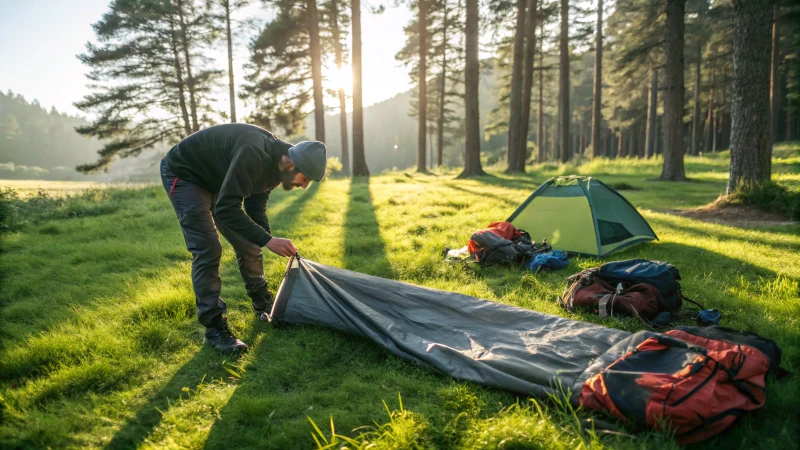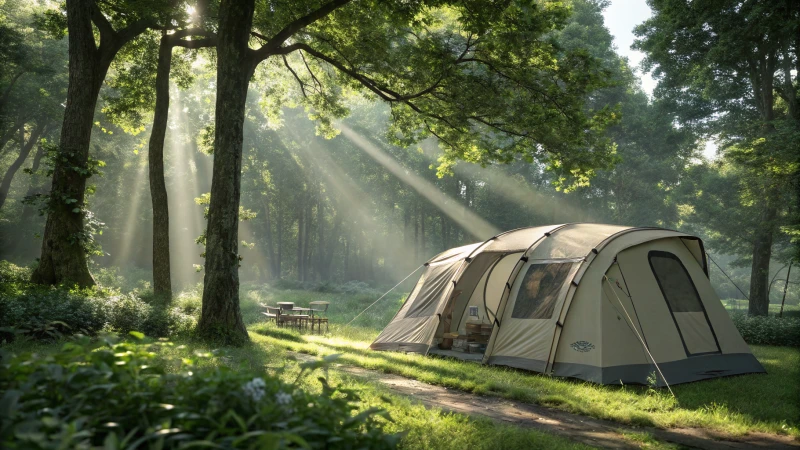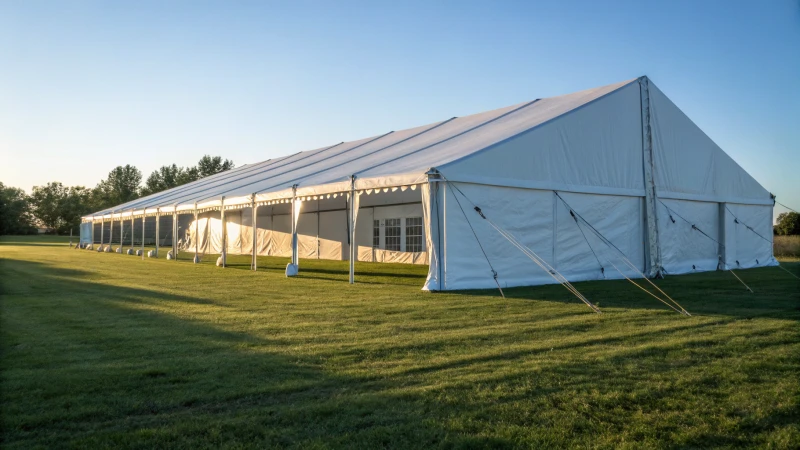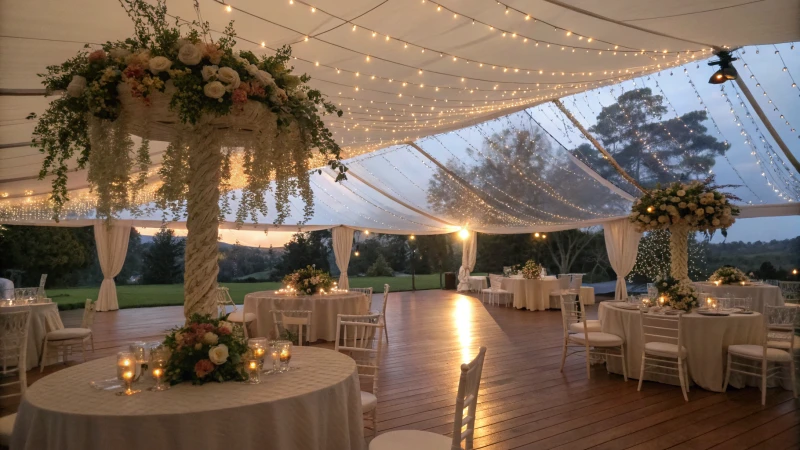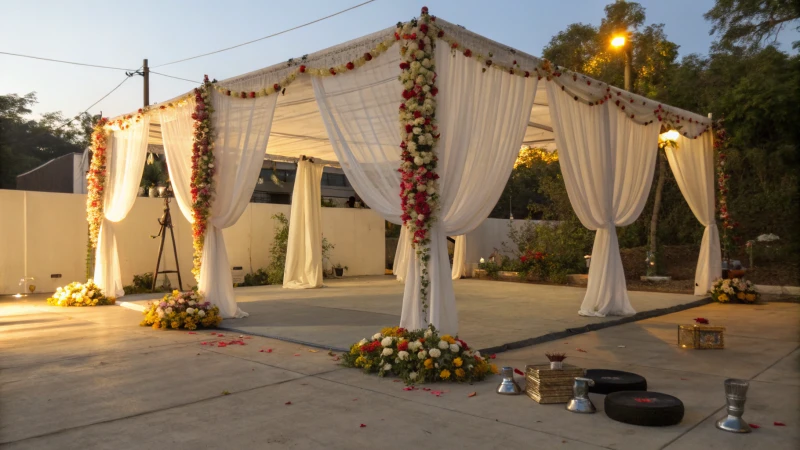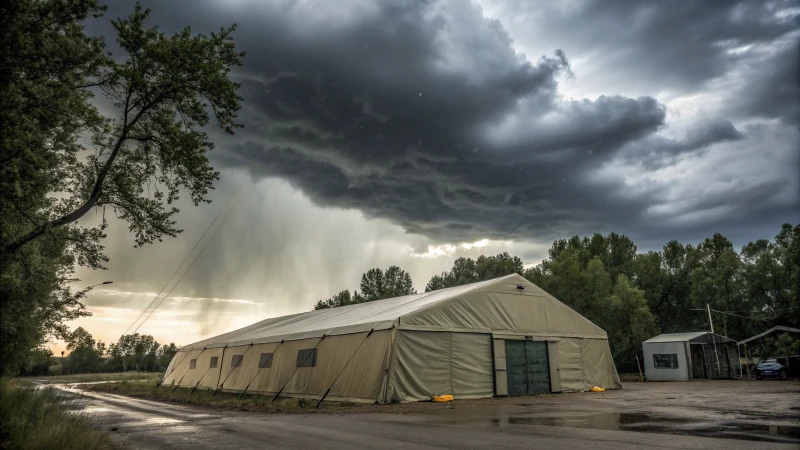
Remember the last time you had to pack up an outdoor event because of bad weather? Industrial tents can save the day.
Industrial tents can withstand harsh weather conditions due to their robust frames, durable materials, and secure anchoring systems. They’re designed to endure winds up to 90 mph, handle snow loads of up to 50 pounds per square foot, and protect against rain and extreme temperatures.
Every time I set up a tent for an event, whether it’s a wedding or a corporate gathering, the weather is always on my mind. Understanding what makes these tents so resilient is key. With their tough frames and high-quality materials, industrial tents aren’t just about standing tall; they’re about ensuring everyone inside feels safe and comfortable, no matter what Mother Nature throws our way. Let’s explore how these incredible structures maintain their strength and reliability.
Industrial tents can resist winds up to 90 mph.True
Industrial tents are engineered with sturdy frames to withstand high winds.
All industrial tents are waterproof and leak-proof.False
Not all industrial tents are made with waterproof materials; it varies.
How Do Industrial Tents Survive Harsh Weather?
Ever wondered why some tents can weather a storm while others crumble? It’s all about the materials.
Industrial tents withstand harsh weather due to materials like galvanized steel frames and PVC-coated polyester fabrics. These offer robust strength, waterproofing, and UV protection.

The Role of Framework Materials
The backbone of any industrial tent is its frame. Commonly used materials include galvanized steel and aluminum. Galvanized steel is known for its corrosion resistance1 and strength, making it suitable for high-wind areas. Aluminum, while lighter, offers excellent portability and durability.
| Material | Benefits |
|---|---|
| Galvanized Steel | High strength, corrosion resistance |
| Aluminum | Lightweight, durable |
Fabrics for Weather Resistance
Choosing the right fabric was a game-changer for me. PVC-coated polyester is my go-to for keeping everything dry as a bone inside the tent. This material provides outstanding waterproofing, preventing leaks even during heavy downpours. Its UV-resistant properties also protect against sun damage, ensuring longevity.
Then there’s polyurethane coatings. They’re like an extra layer of armor for your tent, protecting against abrasions and wear. This makes them ideal for areas prone to physical damage.
Anchoring Systems for Stability
A tent’s anchoring system is crucial for stability in adverse weather. Ground stakes on softer surfaces and ballast weights when I’m on concrete are commonly used to secure tents firmly. For those tricky terrains, ground screws are versatile lifesavers that prevent wind uplift2, a significant risk in storm-prone regions.
| Anchoring Type | Application |
|---|---|
| Ground Stakes | Grass or soft earth |
| Ballast Weights | Concrete surfaces |
| Ground Screws | Versatile terrains |
Insulation and Ventilation Features
Keeping cozy inside the tent during winter months is essential. Insulated panels act like thermal blankets, trapping heat where you need it most. Double-layered fabrics or wall panels provide additional warmth, which is essential for maintaining comfortable temperatures inside the tent.
Integrating vents or an HVAC system helps circulate air efficiently because nothing spoils a day more than condensation issues during summer. These systems ensure that air circulates efficiently, reducing the risk of condensation issues3.
Galvanized steel frames resist corrosion.True
Galvanized steel is coated to prevent rust, enhancing its durability.
PVC-coated polyester is not UV-resistant.False
PVC-coated polyester offers UV protection, preventing sun damage.
How Do Industrial Tents Handle Extreme Wind Conditions?
Industrial tents might seem like simple structures, but their ability to handle extreme winds is nothing short of amazing. Let me share how these resilient shelters stand strong against nature’s gusty challenges.
Industrial tents withstand extreme wind conditions through robust frame construction, strategic anchoring systems, and specialized fabric materials. They are designed to resist winds up to 90 mph when properly installed and maintained.
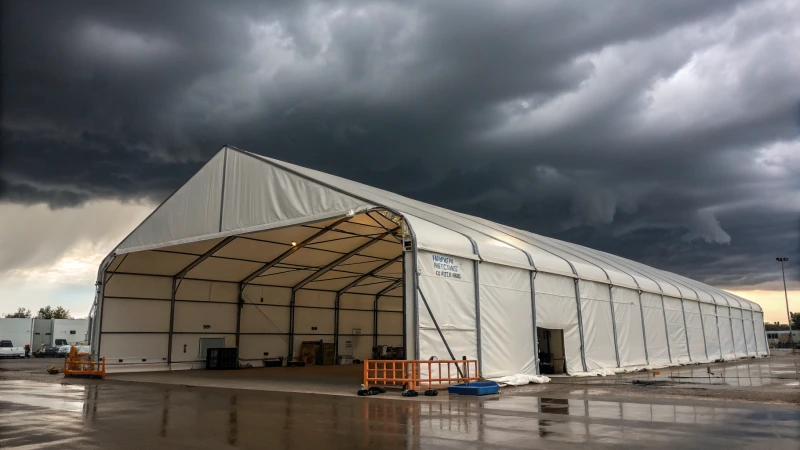
Frame Construction and Materials
When I first started exploring the world of industrial tents, I was fascinated by the engineering brilliance behind their frames. Crafted from sturdy materials like aluminum or galvanized steel, these frames offer a blend of strength and flexibility essential for facing high winds. Aluminum is incredibly lightweight yet sturdy, while galvanized steel boasts excellent corrosion resistance—both crucial for longevity and durability in harsh conditions.
Anchoring Systems
Anchoring was a concept I had to learn thoroughly, especially since the stability of a tent could mean the difference between success and disaster in the field. Depending on where you plan to set up, different anchoring systems come into play. I remember once setting up on grassy terrain4 and discovering that ground stakes were perfect for the job. On another occasion, installing on concrete required ballast weights, which provided that extra bit of stability.
| Anchoring Method | Suitable Terrain |
|---|---|
| Ground Stakes | Grass |
| Ballast Weights | Concrete |
Fabric Technology
The fabric technology used in these tents is another marvel. I once toured a facility where they demonstrated how PVC or polyester materials are not only flame-retardant but also waterproof, maintaining their integrity even under severe weather conditions. It’s like having a shield that stands resilient against tears and leaks.
Strategic Design Considerations
- Wind Load Capacity: During one particularly windy event, I was grateful for the aerodynamic design of our tents, which were engineered to endure winds between 60-90 mph. The reinforced sections made all the difference.
- Windbreaks: Adding sidewalls or barriers can be a game-changer. I recall an open field event where these additions significantly reduced the wind impact on our setup.
Regular Inspections and Maintenance
Ensuring these tents remain secure over time requires regular checks. Before severe weather hits, I always inspect for loose bolts or compromised anchors. Adding cross-braces is another measure I’ve found enhances the tent’s resilience5 during particularly stormy conditions.
These elements work together to make industrial tents not only stable but versatile enough to face adverse weather. Leveraging these technologies6 and strategies ensures that these tents provide reliable shelter, even in the most extreme environments.
Galvanized steel frames resist corrosion in industrial tents.True
Galvanized steel is known for its corrosion-resistant properties.
Ballast weights are ideal for anchoring on grassy terrains.False
Ground stakes, not ballast weights, are suited for grassy terrains.
How do industrial tents hold up in snowy environments?
I remember that snowy winter when everything seemed to be buried under a white blanket. Could industrial tents really stand up to such conditions? Let’s find out.
Yes, industrial tents are suitable for snowy environments when equipped with high-pitched roofs, reinforced frames, and snow-resistant materials. Ensuring proper installation and regular maintenance can significantly improve their performance in managing snow loads.
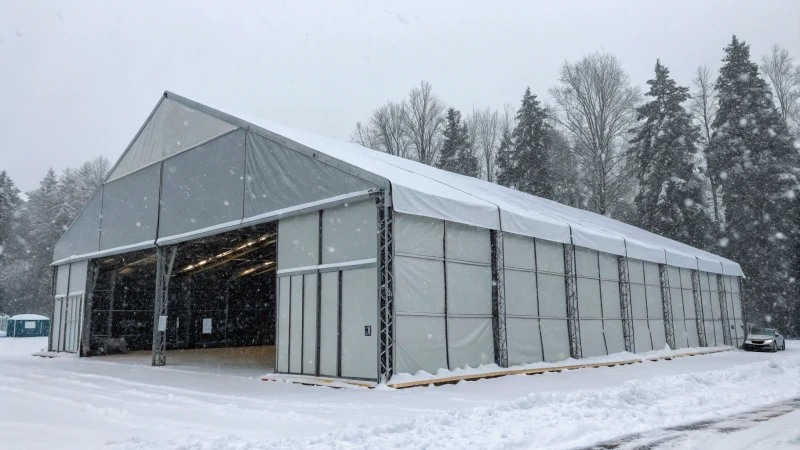
I recall the first time I had to consider using an industrial tent in a snowy climate. The idea seemed daunting at first, but once I understood the essential features, it felt less intimidating.
Key Features for Snow Resistance
Industrial tents designed for snowy environments must incorporate certain features to ensure they withstand heavy snow loads. I learned that a high-pitched roof design7 is crucial. It’s like the way a mountain sheds snow; it allows the snow to slide off rather than accumulate, reducing the weight and stress on the structure.
Materials play a vital role too. Opting for tents made from PVC-coated polyester ensures flexibility in freezing temperatures without cracking. Reinforced frames crafted from galvanized steel add much-needed stability and support.
| Feature | Benefit |
|---|---|
| High-Pitched Roof | Reduces snow accumulation |
| Reinforced Frames | Increases structural strength |
| PVC-Coated Polyester | Prevents cracking in cold |
Installation and Maintenance
Proper installation is paramount. I found that securing the tent with appropriate anchoring systems like ground stakes or ballasts can make all the difference. And let’s not forget about regular maintenance—clearing snow off the roof promptly is vital to prevent excessive weight buildup.
Hiring professional installers is a wise decision to ensure that the tent is set up correctly for the specific environment. In regions prone to heavy snowfall, adding extra support structures8 like cross-braces might be necessary.
Additional Considerations
Beyond structural and material aspects, planning for the tent’s use over time is crucial. Keeping an eye on weather forecasts and taking proactive measures—such as reinforcing anchors or temporarily relocating activities—can avert potential damage.
For those seeking extra assurance, I’d recommend considering integrated heating systems9 within the tent to maintain a stable interior temperature, preventing ice build-up.
FAQs
- What types of industrial tents are best for snow?
- Dome and arcum tents with high-pitched roofs are most effective.
- How do you maintain a tent in snowy conditions?
- Regular snow removal and structural inspections are crucial. Reinforcements should be considered in heavy snow areas.
Understanding these aspects empowered me to make informed decisions when choosing industrial tents for snowy environments, ensuring safety and functionality even in the harshest conditions.
High-pitched roofs reduce snow accumulation on tents.True
High-pitched roofs allow snow to slide off, reducing weight on the structure.
PVC-coated polyester cracks easily in cold temperatures.False
PVC-coated polyester remains flexible in low temperatures, preventing cracks.
How Do You Maximize the Lifespan of an Industrial Tent?
I remember the first time I set up an industrial tent for an event. I had no idea how much care it needed to last through rain, wind, and time.
To maximize an industrial tent’s lifespan, regularly inspect for damage, clean consistently, ensure proper setup, and use protective gear. Prompt repairs prevent further damage.

Regular Inspections
Conducting frequent inspections10 is essential to catch minor issues before they escalate. I’ll never forget that one day when I was setting up a tent for a big event. I noticed a small tear in the fabric—thank goodness I caught it in time! Regular inspections have saved me from many headaches. Check for:
- Tears in the fabric
- Rust or corrosion on metal parts
- Loose bolts or anchor points
Maintaining a log of these inspections can help track wear patterns and prompt timely repairs, ensuring my tents are always in top shape.
Maintain Cleanliness
I’ve learned the hard way that keeping your tent clean can make all the difference. Keeping your tent clean prolongs its life. Dirt and debris may seem harmless, but they can lead to tiny abrasions on the fabric over time. Use gentle cleaning solutions specifically designed for tent materials11. Avoid harsh chemicals that can degrade the fabric over time.
| Cleaning Task | Frequency |
|---|---|
| Debris Removal | After each use |
| Fabric Cleaning | Monthly |
| Frame Inspection | Quarterly |
Here’s how I keep things clean:
- Debris Removal: After each use, remove any dirt or debris.
- Fabric Cleaning: Perform monthly cleaning with appropriate solutions.
- Frame Inspection: Conduct quarterly checks to ensure structural integrity.
Proper Installation
Proper installation is crucial to withstand environmental stresses. A few years back, I learned this lesson when a gust of wind nearly toppled one of my tents. Ensure the tent is anchored securely, particularly in windy areas. Utilize proper anchoring systems like ground stakes or ballast weights to enhance stability, keeping everything safe and sound.
Use Protective Accessories
Adding protective accessories has been a game-changer for me. Consider adding protective accessories such as:
- Sidewalls: Offer additional protection against wind and rain.
- UV Covers: Shield the fabric from harmful ultraviolet rays, reducing sun damage.
These additions have significantly increased my tents’ resilience against harsh conditions.
Promptly Address Wear and Tear
Whenever I spot damage, I act fast. Immediate repairs are vital when damage is detected. Use patch kits12 for small tears and contact professionals for more significant repairs. Ignoring small damages can lead to larger problems, affecting the tent’s structural integrity.
By implementing these strategies, you can ensure that your industrial tent remains durable and reliable, serving its purpose efficiently for years.
Regular inspections prevent tent damage.True
Frequent checks catch minor issues early, preventing escalation.
Harsh chemicals extend tent fabric life.False
Harsh chemicals degrade fabric, shortening its lifespan.
Conclusion
Industrial tents are engineered to withstand harsh weather, featuring robust frames, durable materials, and secure anchoring systems, ensuring safety and comfort in extreme conditions.
-
Galvanized steel is highly resistant to corrosion and strong, making it perfect for stable tent frames. ↩
-
Understanding wind uplift prevention is crucial for maintaining tent stability during storms. ↩
-
Learn effective methods to reduce condensation inside tents for a comfortable environment. ↩
-
Discover which ground stakes provide optimal stability for tents set up on grassy surfaces. ↩
-
Learn effective methods to strengthen your tent’s structure during windy conditions. ↩
-
Explore innovations in industrial tent design that enhance weather resistance and durability. ↩
-
A high-pitched roof helps snow slide off easily, reducing structural stress. ↩
-
Reinforcing tents with cross-braces increases stability during heavy snow. ↩
-
Heating systems can prevent ice build-up and maintain a stable temperature. ↩
-
Regular inspections help identify and rectify issues early, preventing costly repairs or replacements later. ↩
-
Using appropriate cleaning solutions ensures fabric longevity and maintains the tent’s aesthetic appeal. ↩
-
Patch kits provide a quick and cost-effective solution for minor tears, preserving the tent’s condition. ↩



